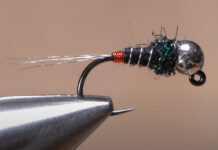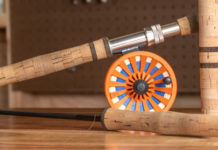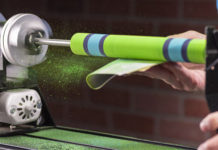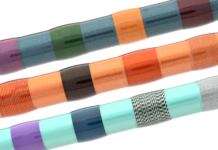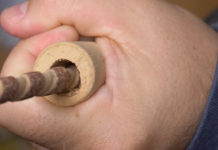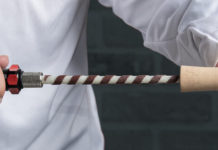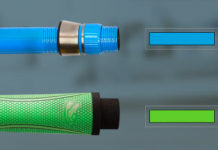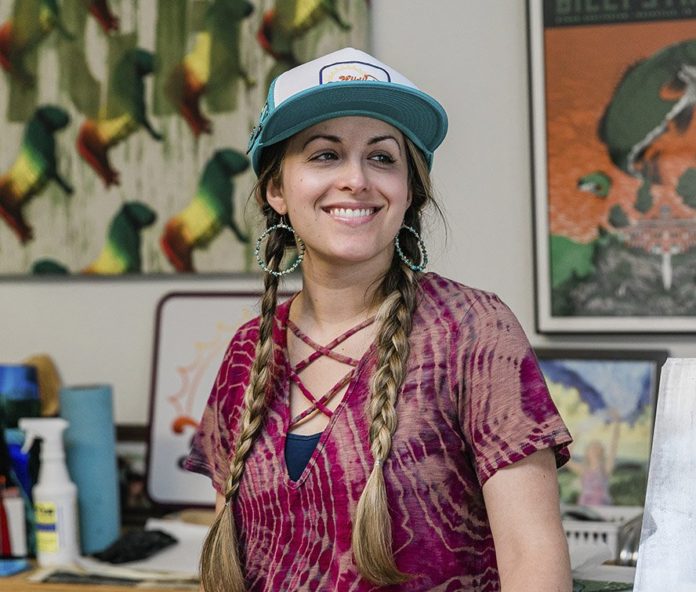Some people call it an “aha moment,” others call it finding your groove. For Colleen Newcomb, the Lexington stained-glass artist behind Wildlight Glassworks, it happened in 2016, when, looking to give a new art medium a try, she borrowed her boyfriend’s old stashed-away stained-glass tools. After several years of dabbling in various artistic pursuits that had never fully clicked – including painting, screen printing and sign painting – something opened up inside Newcomb when she started working with glass.
“I had tried so many things before,” the artist, who just turned 33, said when looking back to her early days of experimenting with different mediums. Admitting she had even found herself at a point where she was questioning whether she was going to be able to make a career out of being an artist, she continued, “I was pretty down and frustrated. But working with stained glass, it clicked fast.”
Stained glass is an art form that dates back to ancient times, when Roman and Egyptian artisans began incorporating it into glassware and other decorative wares. Around the 7th century, glassmakers began to be utilize decorative, colored glass in windows and in religious architecture, a connection that remains familiar today. Over the following centuries, it evolved as a modern art form that lends itself to endless styles and imagery; and its popularity in traditional and contemporary home décor, as well as commercial use, has remained strong.
Trial-and-error defined those early days when Newcomb first started dabbling with the tools that her boyfriend, Michael Martinez, an artist who hand-paints signs for many popular local businesses, had tossed aside. But Newcomb found herself consumed and fascinated with the process from the start, watching videos and reading as much material as she could on the subject. The more she researched and practiced the art form, the more her passion for it grew. While she quickly learned and grew more confident in her skills, Newcomb continued to maintain her retail job for several years, deferring her artistry to a “side hustle.”
“You get accustomed to a steady paycheck – it’s hard to let go and believe it’s going to be OK,” she said. But the artist soon found she was so busy with orders that keeping another job was unsustainable, and in 2019 she made the leap into working for herself full time. The artist said social media – Instagram in particular – coupled with repeat customers and heavy word-of-mouth marketing have helped her build her business, which caters to an increasingly large following from all over the United States and beyond.
These days, her work centers primarily on commissions and custom orders.
“I used to have time to do more shows and festivals, but now I’m so busy keeping up,” she said. A one-woman shop, Newcomb does everything from taking orders, sketching designs, creating the pieces, photographing her work, marketing her business and shipping the finished pieces to their new homes. She tries to create enough pieces beyond her custom orders to participate in a handful of pop-up shows a year and occasionally releases new work in “shop updates” on her website and social media. Those tend to sell out fast, with her followers moving quickly to snag a piece.
Newcomb’s pieces often celebrate mountains, rivers, fish and flowers, as well as another aspect dear to her heart: the iconic band the Grateful Dead. She explained she’s always had a love of the natural world and connected with the Grateful Dead while in high school.
“I know it’s older music and I never got to see the original band live, but I really love the music and it has always meant a lot to me,” Newcomb said. After posting a couple of pieces early in her career that contained visual references to the band, requests for more began to roll in. As demand grew, she has continued to add items that contain imagery from the band’s rich visual legacy into a lot of her work, from lightning bolts to “steal your face” skulls to dancing bears.
Newcomb admitted she’s become a glass freak. During a recent visit to her studio, she pulled several examples of beautifully colored sheets of glass from neatly organized bins, holding them up to the sunlight to show the different qualities she admires. She collects glass the way some people collect vacation souvenirs, visiting glass shops whenever she travels and often finding special pieces she can’t leave behind. She said using certain pieces of glass in a work of art can bring back great memories of when and where she found that particular piece.
And sometimes, she said, she can see by looking at the glass what it wants to be.
“Glass has so many surprising qualities,” she said. “There’s actually different textures, light and grain in the glass, almost like a painter’s brushstrokes. In stained glass, we use glass like a painter’s palette.”
One happy collector is Phil Pietrowski. He and his wife commissioned a Tree of Life image for their wedding at Shaker Village that became the backdrop for their vows. The panel, which is the largest piece Newcomb has created, now hangs in their home along with several other pieces of Newcomb’s work. Pietrowski enthusiastically praised Newcomb’s style and said the artist’s work was a natural fit for them.
“I love her use of color, and she has an outstanding eye for using glass in ways that show texture and depth,” said Pietrowski, adding he has watched Newcomb’s work evolve over the years. “She always experiments and tries new things, and it shows in her work.”
Newcomb’s Wildlight Glassworks Studio is a small cozy space with an efficient layout, where all her tools are arranged not much more than an arm’s length away. She’s surrounded by foils and metals, glass, grinders, hand tools and artworks in various stages of progress. The artist is very much at home in the space, and she lights up when talking about past pieces she’s created and clients she has worked with. She admits she feels lucky to enjoy her work so greatly, and it’s something she hopes shows in her pieces.
Writer Celeste Lewis recently had an opportunity to interview Wildlight Glassworks artist Colleen Newcomb about her work and inspirations.
How did you come to be a stained-glass artist? How did you learn the techniques? I never had any formal art training, but I worked in many different mediums before finding stained glass, none of which were leaving me very fulfilled. I felt like I had something special to offer but wasn’t sure where to direct my focus – honestly, I was at a very low point. My boyfriend, Mike Martinez [the local hand-painted sign artist behind Paint Town Signs], mentioned that I might like making stained glass. I researched some modern glass artists online and felt inspired with possible ideas, so I decided to try this new medium out. Mike had taken a class when he was a teenager and still had some of the tools on hand, so luckily, I only had to buy a few new things. He was able to show me the basics of how to make a piece. From there I learned a lot by researching articles, forums and tutorials online and also lots of trial and error. I would also get tips sometimes from Laura Hallock, who at the time owned a glass shop in Lexington where I bought supplies. That first year everything felt like it was finally falling in place for me. I was so inspired and motivated and really felt like I had finally found my true calling and passion.
How do you choose the imagery you use? And your color palette? All of my pieces [with exception of commissioned logos] are designed by me. I wouldn’t say I choose the imagery as much as it chooses me. I may see one small thing, like a plant or shape or special piece of glass that causes a visual chain reaction in my head, and I just go from there.
My color palette choices are usually based on the subject matter. I try to select glass based on the color, opacity and texture that I think would work best for the image I want to convey. I would say I typically gravitate toward more vibrant colors though.
What inspires you? My inspiration comes from my two main loves: nature and music. I like a lot of different genres of music and I connect to it on a spiritual level. So I’m often listening to music when I sketch. I’m also a sucker for beautifully written lyrics and especially love the lyrical work of [the Grateful Dead’s] Robert Hunter.
Looking at your work, you obviously have a close connection to nature. Tell me more about that. Nature has always been the place where I feel the most at peace. I love immersing my senses in the natural world and just letting that feeling of awe, calm and wholeness wash over me. When I came up with the name for my business, I chose ‘Wildlight’ because I wanted to represent the wild intangible beauty of that feeling. I hope that when my artwork shines in the sun, the viewer can catch a glimpse of that feeling transcending through the piece.
What are some of the challenges when you were starting out? How about now? There is definitely a learning curve to making a nicely finished stained-glass piece. I don’t think any one step was particularly a challenge for me, but it did take a lot of practice, mistakes and learning to get to where I am now.
My biggest challenge at the moment is learning to use a glass kiln so that I can incorporate fusing and other kiln techniques into my stained glass. Glass has so much depth as a medium – there seems to be an endless amount of techniques you can learn!
What do you like best about being a stained-glass artist? I love being able to make any subject matter I want to make. I don’t feel boxed into a particular theme and that feels really great. I also really love glass itself. I am with glass like a jewelry artist is with stones. Some of the pieces of glass that I get are so beautiful I could just hang them in the window as is, without cutting them up!
What is something about your art form that most people don’t know? Stained glass is quite the process! Even if you are making a small piece there are so many steps to go through. I work mostly in the Tiffany method of creating stained glass. A typical piece for me looks like this: sketch/design, pattern-making, glass selection, layout, cutting, grinding, foiling, soldering, cleaning, patina, cleaning, buffing, photographing, shipping. It’s all a labor of love.
Tell me a little about what role you think the visual arts play in our lives. I think they play a major role. Just like I connect with nature and music on a spiritual level, I think we also connect with art in that way. It can be therapeutic to the creator as well as the viewer.
Tell me about Wildlight Glassworks. How’s business? How do you utilize social media? My business is mainly online. Pre-COVID, I did participate in various local markets put on by the Lexington Art League and Crafted Social. I have a website, and I mostly use Instagram to share my work. I make a lot of custom work for personal commissions and one commercial commission [the door transom at Wolf & Ryan Salon on Second Street]. I typically work on customs while also building up inventory for timed shop updates that I advertise leading up to on Instagram.
What’s another passion besides stained glass? I’m pretty much a workaholic, and stained glass is really my main passion. When I do get time away from it, though, I like to be outside hiking, rock climbing and fly fishing. I make a lot of fish-themed stained glass. I also enjoy playing the piano, spending time with my family and seeing live music.
“When you feel really good about something you are making, people can feel that,” she said.
Credit: Source link






